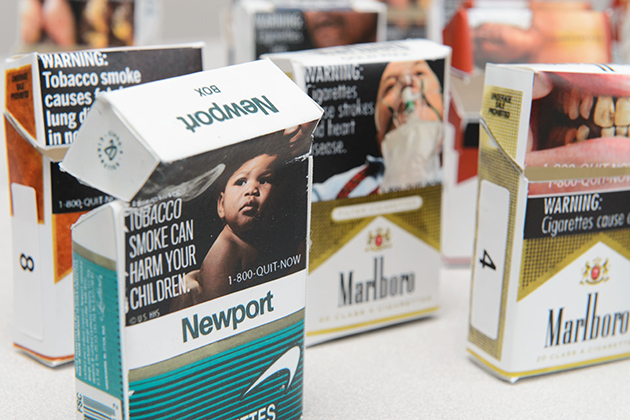
UConn communication professor Leslie Snyder, director of the Center for Health Communication and Marketing at CHIP, is conducting research to assess the potential impact of controversial new graphic warning labels for cigarette packages and to suggest directions for future national anti-tobacco campaigns. The research is funded by a grant of nearly $1 million from the National Cancer Institute.
New labels, which were to cover 50 percent of cigarette packs, are a requirement of the 2009 Family Smoking Prevention and Tobacco Control Act, which also gave the U.S. Food and Drug Administration (FDA) authority to regulate tobacco products for the first time. The new graphic warning labels were supposed to be on boxes starting September 2012, but legal challenges by tobacco companies caused the FDA to withdraw the first proposed set of labels. In the future, it is likely that the FDA will propose a new set of labels – taking into account research by Snyder’s team and others.
The nine images initially selected by the FDA include a healthy and smoke-blackened lung side by side, a man smoking through a tracheotomy hole in his neck, and a staged photo of a corpse on a coroner’s table.

FDA officials called these graphic warnings “the most significant change to health warnings in 25 years.”
Snyder’s research team created sample cigarette boxes with the proposed FDA warning labels to show study participants.
Snyder, a CHIP principal investigator whose health communication and marketing center is a CDC-established Center of Excellence, specifically studied the impact of the graphic warning labels in two high-risk populations: youth and pregnant women.
The work involved teenagers ages 13 to 18 recruited from two Hartford high schools with predominantly African American and Puerto Rican populations, and from two other areas of the country (Nashville and Milwaukee) with relatively high teen smoking rates. Young adults 18 to 24 years old also were studied using Internet-based surveys.
The pregnant women from various target populations (urban and rural African Americans, urban Puerto Ricans, Native Americans, Native Hawaiians, rural whites, and non-rural whites) were recruited from locations across the country.
To understand how people react to the graphic warning labels, Snyder used experimental and control groups, with only some individuals in the target populations being shown the nine proposed labels. Snyder and her colleagues anticipated that different images would prove more effective with different target populations.
In addition to studying reactions to the images, Snyder’s team conducted surveys, focus groups, and interviews to elicit and test additional targeted messages to reduce smoking initiation and promote quitting among smokers. The research is being used to inform a new youth tobacco prevention program the FDA plans to launch next fall or winter. Snyder and her team have been sharing their preliminary findings with the FDA and with the contractors hired to run the youth campaigns.
For example, a national survey testing the influence of the FDA graphic warnings on young adults found that they had a positive impact on occasional smokers – those who smoke sometimes but not daily – causing them to rate smoking as less desirable and have low intentions to smoke in the coming months compared to young adults in a control group. Occasional smokers are important to target because they often do not realize the health and addiction risks they face, and may have an easier time stopping, Snyder says.
Other preliminary findings from focus groups with teens found that warnings work best when they demonstrate how smoking can damage your body inside (lungs) and outside (teeth and mouth).
Interviews with 105 pregnant women from around the country suggested that pregnant women respond strongly to both graphic warning labels and other messages addressing the effects of smoking on the fetus, on mothers, and on children in households with second-hand smoke.
Snyder’s message development and testing for the pregnant smoker target populations aims to achieve two goals: smoking cessation and “staying quit” after pregnancy.
“Half of pregnant women stop smoking during pregnancy before their first doctor’s visit, but a significant number of those women start smoking again after having their babies,” she notes.
Snyder’s collaborators at UConn include CHIP affiliates Dr. Michelle Cloutier, a UConn Health Center (UCHC) and Connecticut Children’s Medical Center (CCMC) pediatric pulmonologist; Dr. Cheryl Oncken, also from the Health Center, who specializes in smoking cessation in pregnant women; and psychology professor Hart Blanton. Cloutier’s team at CCMC is conducting the warning label research in Hartford with teens and pregnant women. Oncken is consulting on the project design, potential messages, and interpretation of findings with pregnant women. Blanton is working on understanding the psychological reactions to the graphic warnings and the persuasion strategies that can be used in future FDA campaigns. The project manager for the team is Joy Larson.
Snyder is conducting her study as part of an elite group of researchers. Other research centers that received National Cancer Institute funds to study the impact of the graphic warning labels with different target populations include the Lung Cancer Disparities Center at Harvard University; the Annenberg School of Communication at the University of Pennsylvania; and the Health Communication Research Laboratory at St. Louis University.



